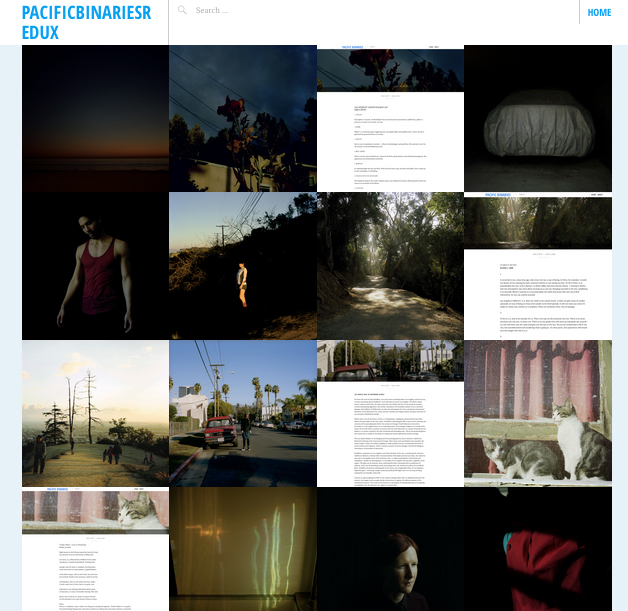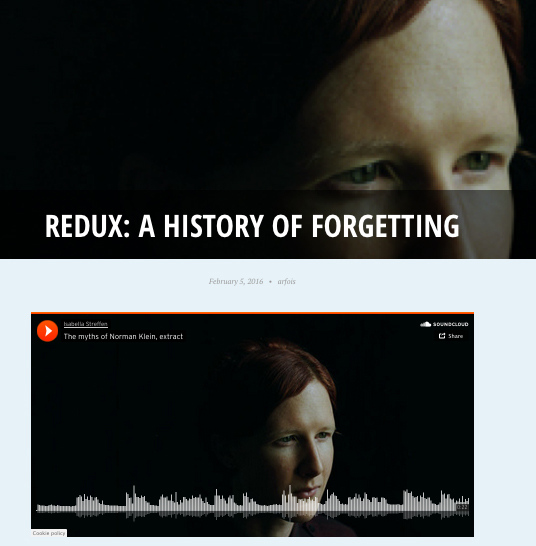Return to Theme Table of Content
The And Or project (&/) is a research group and digital exhibition space, reimagining the relationship between art, interpretation, exhibition, and theory. We are a collective of three: artist, art writer and art historian. Instead of being guests in each other’s domains, we have generated a collaborative space. &/ is both an online exhibition project and itself an investigatory work, inviting collaborators and commissioned contributors to critically experiment with the internet and reconsider the interaction between printed matter and new media art. We launched our online exhibition space in February 2014. We present two to three shows per year in collaboration with artists, art writers and web designers. &/ is Sarah Archino, Siofra McSherry and Isabella Streffen.
(image below is linked to the project homepage)
The And Or project presents a remixed and re-evaluated recap of our current online photography exhibition, Pacific Binaries: Redux. In remixing the show we aim to explore the nature of the digital photograph and the issues involved in its exhibition.
For their second online exhibition, the And Or project editors presented a photographic series on Los Angeles by Berlin-based artist Anja Schaffner. The web-based show featured new writing from Alison J. Carr, Roddy Lumsden, Monica Steinberg and Isabella Streffen, which responds to and reflects on the photographs and the imagined Los Angeles they invoke. Schaffner’s images capture delicate mundanities within the car-centric megalopolis of Los Angeles. She didn’t learn to drive in order to read L.A. in the original, or dwell on the ecology of fear, or mine the history of forgetting; instead, she sought out slow moments of beauty, nostalgia and fiction. The images documented the last days of iconic Angeleno twilight, prior to the city’s shift to more environmentally-friendly white LEDs.
(select image to access the page below)
This remix emphasises the inaccessibility of the photographic archive and the original materials from which the digital exhibition is extracted. Although Schaffner shot in analogue and the printing process was important to her vision of the work, we and ultimately the viewer have access only to high-resolution scans of the photographs online. In our new version of the show, we have increased the inaccessibility of the work by providing screenshots of the texts that formed part of the original, and have added our own commentary, at times both explicatory and obfuscatory, via the barely-visible medium of audio.
We address the issue of dissemination as the manifestation of the deep paradoxes that underlie the conceptual matrix of the show. Despite being accessible to everyone with an internet-capable device, regardless of location, the exhibition deals with distance and inaccessibility: distance from the city; from the dreamed city; and the geographical separation of contributors (a separation that takes place also in time, from CET to PST). The show’s paradoxes echo the tensions of hosting an exhibition driven thematically by location, existing in the non-place of digital and coordinated by global participants from outside the site, and opening up the space of an imaginary and re-imagined Los Angeles within a re-imagined and remixed exhibition.
Thus, the objectlessness of Pacific Binaries Redux comments on both the subject and the form of the original exhibition. The subject of Schaffner’s photographs, Los Angeles, is more than a physical city – it is an ineffable, imaginative site, a highly concentrated node of fantasy and aspiration. The photographs lay no claim to capturing or documenting a totality. Similarly, while the digital exhibition is only a temporary site, the trace of that show as preserved through this remix is highly subjective, mediated through low-resolution screenshots and disconnected audio. We make no claims that digital presentations can or should live forever, nor that the archive can contain and document the original. Thus, our publication and republication of these photographs obscures and erases as much as it conserves and presents.


